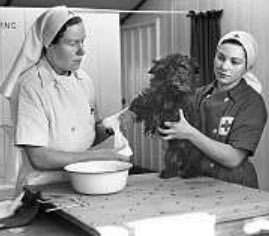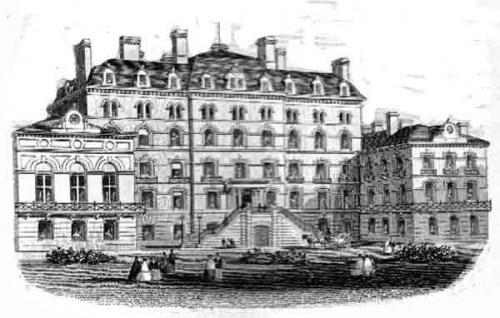St Saviour's Road encompasses many aspects of Jersey society, including religion, tourism, education, health and charitable institutions.
There were just a few properties shown alongside this major route from St Saviour to St Helier on the 1795 Duke of Richmond map. From the mid-19th century, maps show the middle to upper part of the road named Le Coie, which, as Jerripedia's guide to Jersey place names indicates, means 'quiet place'.
The early development of the road was predominantly residential and it remained this way until the tourism boom of the 20th century. Other than the odd grocery shop or inn, there were few other commercial properties along the road, apart from a soap and candle making factory on the site of Liberation Court.
Soap manufacture
The 1881 census records Philip Le Rossignol as a soap manufacturer employing four men at 22 St Saviour's Road. Philip inherited the business in a contract dated 1869 as the eldest son of Captain Philip Le Rossignol. He received a house or houses for the manufacture of chandelles and savon (candles and soap) with all the tools and machinery for the usage of the business. Earlier contracts show that the soap factory had been on this site since at least 1798 when the Journeaux family were the owners.
The Le Rossignol family kept the business running into the early 1900s, but by 1928 the factory had closed and the house on the site was sold to Florence McDermott, who opened a small hotel there called the Continental.
Imperial Hotel
This was not the first hotel on the road. The Imperial Hotel was opened much earlier, in 1866, built on the site of a house called La Fregonniere, owned by property developer George Ingouville.
The Jersey Imperial Hotel Company built the large hotel, which according to newspaper reports was designed by Medland and Maberly Architects and constructed and furnished by reputable English companies. A report in the London City Press dated June 1863 reads:
- "The Jersey Imperial Hotel Company is formed for the purpose of construction of a first-class hotel at St Helier, the hotel accommodation being very inadequate in the island, and not adapted for the better class of visitor. The nominal capital is £40,000 in shares of £10 each."
The venture was a financial disaster and despite attempts by various companies to save the hotel, it was sold at a fraction of its cost to an exiled French Jesuit order for use as a seminary, renamed Maison St Louis.
In 1941 the German authorities requisitioned the building for their own use and the seminary was moved back to France. The Jesuit order sold the property to Maj J Reynolds in 1963 and he restored the building to a hotel, called Hotel de France.
Hotels and guest houses
The growth of the tourism industry in Jersey in the mid-20th century saw the transformation of many private residences in St Saviour's Road into hotels and guest houses. The Jersey Tourism official accommodation list for 1961 contains 25 hotels or guest houses, ranging from those with 50 rooms, such as the Continental Hotel, Woodville Hotel and Mayfair Hotel, down to smaller bed-and-breakfast accommodation such as the Franklyn, La Reserve and Pentland Lodge.
Many of the larger hotels were requisitioned by the German forces during the Occupation. The Continental Hotel was used as the billet for many of the German soldiers who worked at the Feldkommandantur at College House.
The Mayfair Hotel became the first Soldatenheim, or soldiers' home, to open in the island on 5 July 1941. The Mayfair first opened in 1930 when Arthur Woodhall and his wife Emily bought 46 St Saviour's Road, a house which had been in the Nicolle family since 1876, when Francis Bertram gifted it to his grandson.
In 1934 the Woodhalls purchased 38 St Saviour's Road to expand their hotel. Arthur and his family were evacuated before the Occupation and left the hotel in the hands of his brother, Frederick. The German forces allowed Frederick and his Austrian wife, Marie Schneider, to remain in a flat on top of the Mayfair Ballroom. The couple reportedly used this accommodation to provide sanctuary for two escaped Russian slave workers from 1944 onwards.
Schools
There are several schools close to St Saviour's Road today, but it was previously home to a number of small private schools, generally run by well-educated daughters of upper-class families, in private houses, catering for day students as well as boarders from colonial families.
The largest of these was a school for girls called Elysian House School, which was situated at 13, 15 and 17 St Saviour's Road, part of a terrace of four properties called Elysian Terrace. This was built by Henry Le Vavasseur dit Durell, a merchant, on land he acquired from Edouard Le Couteur in 1842.
Sisters Florence and Ada Stevens opened the school in 1899, renting the three properties. It remained open until 1912 and the Jersey Archive holds a collection of school yearbooks containing writings, paintings and photographs which give a fascinating insight into the students' lives.
Animals Shelter
The Jersey Animals Shelter has its headquarters in St Saviour's Road. It was founded in 1913 by Frances Elizabeth Wilson, the daughter of the Rev John Alexander Wilson. In 1924 Frances and her sister Charlotte bought 95 St Saviour's Road and four years later gave the property to the Animals Shelter. The contract stated that it was to be used exclusively by the institution to maintain and develop the work begun by the two sisters as a temporary shelter for abandoned, sick, injured and stray domestic animals; a place where animals could be put to sleep, if necessary, without pain, and a place to generally encourage the good treatment of all domestic animals.
In 1931 the Shelter bought 89 St Saviour's Road, known as Coie Manor Farm, a much larger property with extensive grounds bordering Beaulieu, the Woodville Hotel and Coie House. The property dates back to the 18th century and is still home to the Shelter.
The Jersey Society for the Prevention of Cruelty to Animals and the Shelter were amalgamated in 1936 and the following year No 89 was transferred to the JSPCA. Frances Wilson continued to live at No 95 until her death in 1937 and Charlotte at Coie House until she died in 1959.
The Shelter was of vital importance during the Occupation and had the unenviable task of putting to sleep the loved animals of those owners who were evacuated just before the Germans forces arrived. Records show that over the course of four days in June 1940 more than 6,000 cats and dogs were humanely put to sleep. The Shelter provided meat rations for pets from horse meat and offal that had been previously dumped and there were often long queues on a Saturday, with owners desperate to obtain food for their pets.



